By Vincent Van Ross
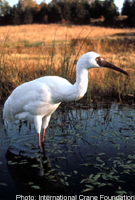
The rarest bird on the Indian soil in recent years and a winter visitor to Keoladeo Ghana National Park (KNP) in Bharatpur, the Siberian crane, has not shown up since 2002. Some reports claim that these migratory birds of the central flock which breed in Siberia during the summer months and visit India for wintering is now extinct. However, nature is too complex to draw such a conclusion. As a bird watcher and a wildlife enthusiast, I have always believed that there is nothing quite final in nature. Birds believed to be extinct have resurfaced in the past. Even resident birds are known to shift their locations when their habitats become untenable due to degradation. So, it should not surprise anyone if the Siberian crane(s) landed at another site en route or near KNP and reappear after a few years because a major portion of the water sheet in the national park has gone dry.
The lineage of the Siberian crane has been traced to a bird group whose fossilised remains date back to 40-60 million years ago. Out of the 14 species of cranes that are known to exist today, seven are endangered. The Siberian crane is one of them.
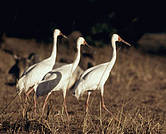
Five species of cranes are found in India: the black-necked crane; the common crane; the demoiselle crane; the sarus crane; and, the Siberian crane. Out of these, the Siberian crane, the black-necked crane and the sarus crane are listed as endangered species in the status report prepared by The World Conservation Union (IUCN) in collaboration with the Species Survival Commission (SSC). According to the International Crane Foundation, the current population of Siberian cranes in the world is estimated around 3,000.
The Siberian cranes have visited India for centuries. The earliest record of its presence in India is a miniature painting by an artist belonging to the period of Jehangir’s reign (1605-1628). Their visits to Bharatpur have been regularly recorded until 1880. Around this time, the Maharaja developed the marshlands around Keola Deo temple into a hunting preserve for duck shooting and to entertain visiting dignitaries. As a result of this disturbance, the Siberian cranes searched for alternate sites. They were known to have spent their winters in other wetlands in north India including Ladakh.
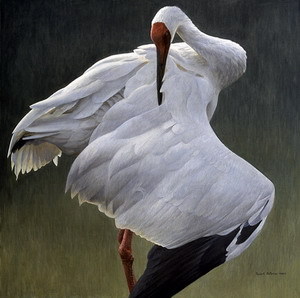
In 1956, Keoladeo was declared a sanctuary and it became the Bharatpur Bird Sanctuary. Four years later, in 1960, the Siberian cranes reappeared in Bharatpur after a gap of 80 years! That was probably because the ban on hunting following the declaration of the wetland as a sanctuary worked as a confidence building measure for the birds. That year only three Siberian cranes were seen at Bharatpur. But, their numbers grew rapidly and no fewer than 200 Siberian cranes were recorded by Walkinshaw in 1964-65. Since then, the population of Siberian cranes in India has witnessed a steady decline. In 1969-70, Spitzer counted 76 birds. In 1975-76, Sauey recorded 68 Siberian cranes. By 1981-82, when Dr. L. Vijayan of the Bombay Natural History Society (BNHS) started counting Siberian cranes, the number had fallen to 44 and its population in India dwindled to a mere 5 during his last count in 1992-93. Thereafter the Forest Department took over the responsibility of Siberian crane count. In the meantime, the Bharatpur Bird Sanctuary was raised to the status of a national park in 1981 and renamed Keoladeo Ghana National Park.
Unfortunately, the Siberian cranes did not arrive in 1993-94. When they did not arrive in 1994-95, there was panic in ornithological circles and many believed that we had seen the last of the Siberian cranes. When I met Dr. Prakash Gole, a crane expert from Pune and a contemporary of Dr. Salim Ali, with whom I had participated in sarus crane counts in the 1980s, he had a positive outlook and he was quite hopeful. He told me that just because they did not arrive for two consecutive years does not mean that they are gone forever. He said they might have strayed to some alternate sites because the habitat may not have been conducive for their winter stay in KNP. Believe it or not, there was widespread cheer when the loud , unmistakable rattling calls of the Siberian crane “kar-r-r-o-o-o” rented the air in the winter of 1995 and the forest department staff saw 4 Siberian cranes (3 adults and 1 juvenile) descending on Bharatpur. Sohan Lal, a forest department staffer who had worked with Dr. Salim Ali for 10 years, recalls this landing of Siberian cranes with a lot of excitement and happiness.
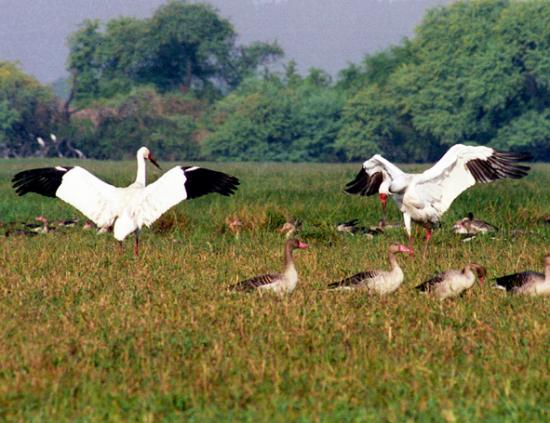
In 1987, just 34 Siberian cranes arrived at the end of the year and, by January 1988, over two-thirds of these had moved out of the national park. Their alternate wintering grounds could not be identified. In 1989, the BNHS staff spotted a lone Siberian crane at Dihaila lake in Madhya Pradesh nearly 200 km away from Bharatpur. Later, Dr. Sunayan Sharma, the Director of KNP who was doing his first stint as the Wildlife warden of the park, sighted a pair of Siberian cranes at Dholpur in Madhya Pradesh. Dr. Salim Ali himself had seen Siberian cranes at the Payagpur Lake in Uttar Pradesh. Siberian cranes have also been found feeding in Bihar.
Siberian cranes are highly territorial. Vivek R. Sinha gives a graphic description of the extraordinary display of a pair of Siberian cranes which were trying to defend their territory from another pair which was trying to land in the nearby area in Bharatpur. He says: “One drew its head back until the neck assumed an ‘S’ shape. It now dropped its neck almost to the water level, turned its bill up towards its breast, puffed up its feathers, lowered its wing-tips and uttered a series of bugle-like calls…The bird then extended its head skywards, towards the approaching cranes, and continued its flute-like calls, moving its neck over a 30 degree arc. A similar posture was simultaneously adopted by its companion which added its higher pitched notes to that of the first bird, the sounds emerging like the two-syllable call of a solitary bird. It is always the male who calls first, followed by his mate.”
The Siberian crane is a red-faced, snow-white bird with jet black wing tips which are visible only when the bird spreads its wings or is in flight. Almost as tall as an average man, the Siberian crane stands tall at 5 ft. Males and females look alike. However, females are slightly smaller in size. One of the best ways to identify the sexes it to see which of the pair calls first. The plumage of the immature Siberian crane is of cinnamon-rufous in colour. The oldest documented crane (all species of cranes taken together) was a Siberian crane named Wolf who lived for 83 years and finds mention in the Guinness Book of World Records.
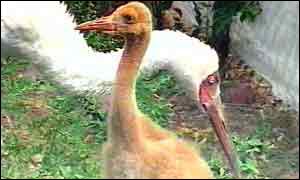
Siberian cranes prefer to feed in shallow wetlands with a depth ranging from 25 cm to 68cm. Siberian cranes are omnivorous. They forage for seeds, leaves of lilies, tubers of sedges and rhizomes in shallow waters and occasionally feed on insects, molluscs and worms.
Russian Scientists have identified three populations of the Siberian crane which breed in the Tundras of Russia during summer—the eastern, the western and the central populations. They nest in bogs, marshes and other shallow fresh water wetlands with good visibility. The nests are round in shape and about a metre in diameter. During the breeding season which begins in early May, pairs are widely scattered keeping a distance of about 25 km between them. By May end or June beginning the nests are ready. Siberian cranes are monogamous. Females usually lay two eggs. The incubation period is approximately 29 days. Both the parents take turns at incubation. However, the responsibility of defending the nest rests primarily with the male. Yellow coloured chicks emerge out of their egg shells after the incubation period. The chicks are capable of feeding themselves though some young ones have been seen begging for food from their parents. Usually, it is the stronger of the two chicks that survives due to sibling rivalry. Chicks start flying after 70-75 days. Siberian cranes become sexually mature between four and six years of age.
The eastern flocks of the Siberian cranes which breed in Yakutia migrate to Poyang lake in China. The western and central flocks which breed along the river Ob migrate to Ferudunkenar in Iran and Bharatpur in India respectively. The 6,000 km migratory route of the central flock which comes to India is fraught with dangers. The central flock flies from Siberia to India via Kazakistan, Uzbekistan, Turkmenistan, Afghanistan and Pakistan. Their winter migration begins in September and their return migration begins in February. While the winter migration is spurred by paucity of food supplies (which get buried under heavy snow in Siberia), the return migration is believed to be spurred by the rising temperature in their wintering sites which affects their nervous system. By this time, the snow begins to melt in Siberia thereby making way for their food. Once they return to Siberia, the parents drive away the juveniles of the last season and start nesting for the next breeding cycle.
Explaining the reasons for non-arrival of Siberian cranes in India, Dr. Sunayan Sharma, Director of KNP, says: “there is a possibility that they might have been shot while they were flying over Afghanistan which has been a war zone for decades. But, if they arrived in India, they might have strayed to other locations as there is scarcity of water in the park. We have not given up hope. In fact, we tried to confirm a reported sighting of two Siberian cranes in another wetland in India by a birdwatcher. We sent our team twice to investigate this claim. But, unfortunately, they were not able to spot the Siberian cranes.”
In 2003 and 2004, there was shortage of water in KNP owing to poor rainfall. In 2005, there was sufficient water. Yet, the Siberian cranes did not come. In 2006 and 2007, there has been scarcity of water again. One of the reasons is: the water which was to come from Panchna dam got diverted for irrigation purposes as a local politician and former minister of Rajasthan, Dr. Kirori Lal Meena, and his supporters laid siege of the Panchna dam and threatened to commit suicide if water was released to KNP.
The park authorities and the state government are working towards a lasting solution to the water problem in the KNP which is a world heritage site. The blue prints for three projects were ready when I visited the park three months back. There was a project to connect the Chiksana canal to the park; there was another project to lift water from Dholpur along the Chambal river through a 80-90 km pipeline; and, a third project was under implementation to bring water to KNP from the Govardhan drain in Mathura. Out of these, the water channel from Chiksana canal has been completed. And, the rain gods have been kind to the park so far. As of now, there is enough water in the park to encourage breeding of resident birds which are largely waterfowls. If all these projects are completed by 2010, there should be sufficient water in the park. Unfortunately, the Goverdhan drain project is yet to take off.
There are a couple of other reasons for decline of the Siberian crane population in the world. Usually, the Siberian cranes lay only two eggs. Even if both of them hatch, only one of them survives because of sibling rivalry. Skuas and gulls attack the nests of Siberian cranes when they are unattended. The nests in Yakutia are also destroyed by dogs and reindeers. Once they lose their eggs, the Siberian cranes do not have sufficient time to re-lay eggs as the Tundra summers are short.
According to Dr. Sunayan Sharma, George Archibald of the International Crane Foundation has offered to help introduce captive-bred Siberian cranes into the wild once the water situation improves in Bharatpur. They would spend the winter in the park and when it is time for their migration, a specially designed micro-light aircraft would be used to guide them on their migration to Siberia as the young birds do not have adults to follow. Once they reach Siberia, their natural instincts would be stimulated and the road map of their migratory route would be etched in their memory. The young Siberian cranes usually memorise the migratory route while migrating back and forth with their parents. A similar experiment on the whooping crane involving Canada and the United States of America has met with considerable success in the last few years. The captive reared whooping cranes introduced into the wild now migrate unaided.
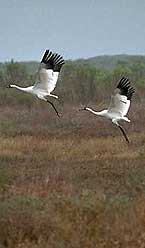
As I said earlier, there is nothing quite final in nature. If all goes well, we may see the Siberian cranes in Bharatpur again, one way or the other!




